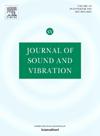Weak stiffness-induced regulation of strongly directional waveguides in anti-tetrachiral spiral metamaterials
IF 4.3
2区 工程技术
Q1 ACOUSTICS
引用次数: 0
Abstract
In-plane weak stiffness and low-frequency strong directional wave regulation at high tensile strains are key considerations for engineering applications. To overcome this problem, a novel anti-tetrachiral spiral metamaterial with low-frequency wave regulation under high tensile strain is designed by introducing Archimedean spiral holes into the perforated plate. The wave attenuation properties and Poisson's ratio characteristics of the proposed anti-tetrachiral spiral metamaterial are investigated through numerical simulations and experimental testing of prototype samples fabricated by additive manufacturing. The results show that weak stiffness is the key factor contributing to the low-frequency bandgap (BG) and zero Poisson's ratio (ZPR) characteristics. The Bragg-type and local resonance-type wave can be interconverted by regulating the stiffness to possess the low-frequency strong wave attenuation capability. The BG frequency of the proposed metamaterial is reduced to 7.88 ‰ of a conventional perforated plate, and its tensile stiffness and maximum mises stress are reduced to 0.23 ‰ and 12.12 ‰ of a conventional perforated plate. Furthermore, the design of four types of waveguide paths with negligible susceptibility to tensile deformation. ZPR structures at weak stiffness have strong directional wave regulation capability in the low-frequency domains, which enables stable wave transport properties independent of tensile deformation. The designed ZPR structures with low in-plane stiffness and low-frequency BG characteristics as well as the strong directional wave regulation are expected to play a key role in the design of future high-performance waveguide devices and tunable BG materials.
反四手螺旋超材料中强定向波导的弱刚度诱导调节
面内弱刚度和高拉伸应变下的低频强定向波调节是工程应用的关键考虑因素。为了解决这一问题,通过在穿孔板上引入阿基米德螺旋孔,设计了一种在高拉伸应变下具有低频波调节的新型抗四手螺旋超材料。通过数值模拟和增材制造原型样品的实验测试,研究了反四手螺旋超材料的波衰减特性和泊松比特性。结果表明,弱刚度是影响低频带隙(BG)和零泊松比(ZPR)特性的关键因素。通过调节刚度可实现布拉格型和局域共振型波的相互转换,具有低频强波衰减能力。该材料的BG频率降至常规穿孔板的7.88‰,其抗拉刚度和最大mises应力分别降至常规穿孔板的0.23‰和12.12‰。此外,还设计了四种可忽略拉伸变形敏感性的波导路径。弱刚度的ZPR结构在低频域具有较强的定向波调节能力,可以实现不受拉伸变形影响的稳定波输运特性。所设计的ZPR结构具有低面内刚度和低频BG特性以及强定向波调节能力,有望在未来高性能波导器件和可调谐BG材料的设计中发挥关键作用。
本文章由计算机程序翻译,如有差异,请以英文原文为准。
求助全文
约1分钟内获得全文
求助全文
来源期刊

Journal of Sound and Vibration
工程技术-工程:机械
CiteScore
9.10
自引率
10.60%
发文量
551
审稿时长
69 days
期刊介绍:
The Journal of Sound and Vibration (JSV) is an independent journal devoted to the prompt publication of original papers, both theoretical and experimental, that provide new information on any aspect of sound or vibration. There is an emphasis on fundamental work that has potential for practical application.
JSV was founded and operates on the premise that the subject of sound and vibration requires a journal that publishes papers of a high technical standard across the various subdisciplines, thus facilitating awareness of techniques and discoveries in one area that may be applicable in others.
 求助内容:
求助内容: 应助结果提醒方式:
应助结果提醒方式:


